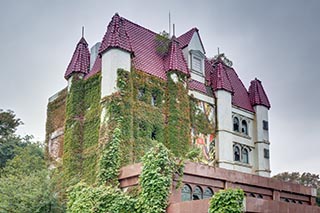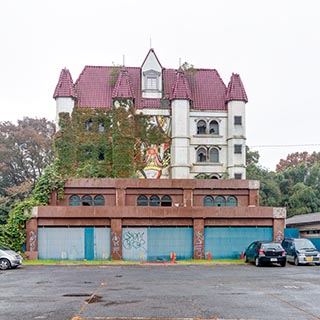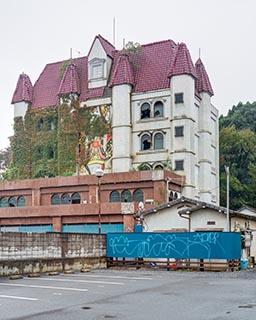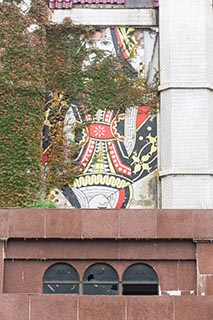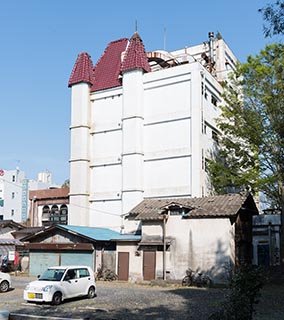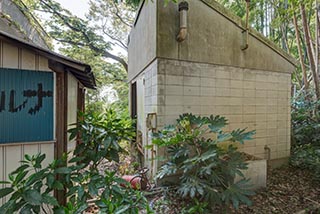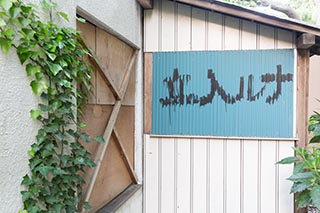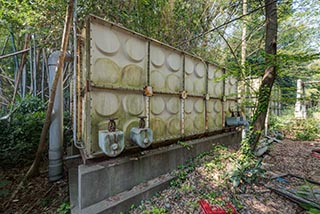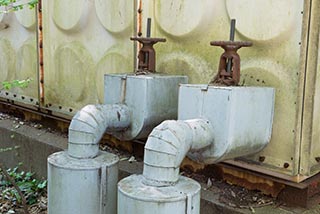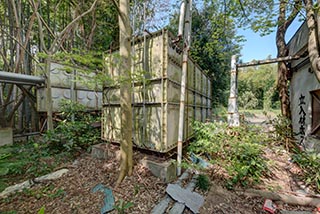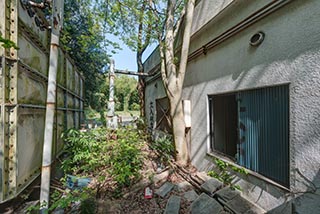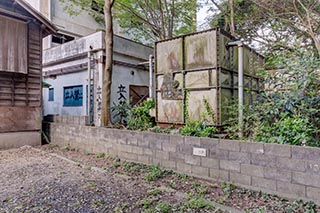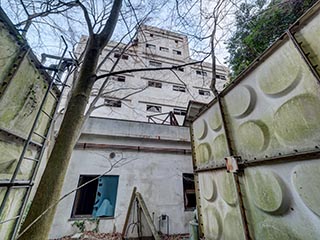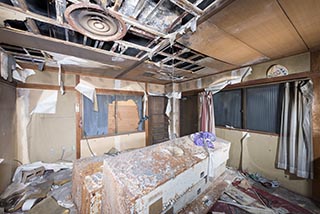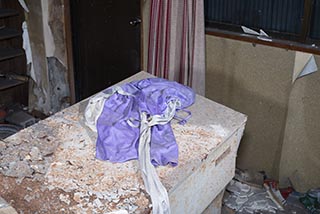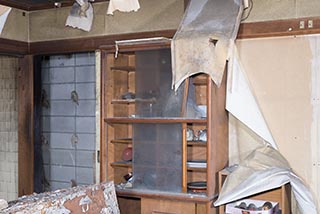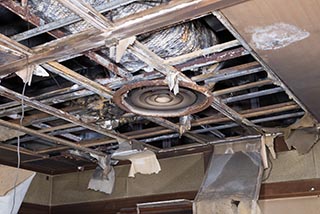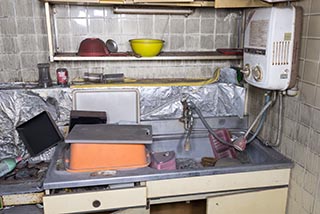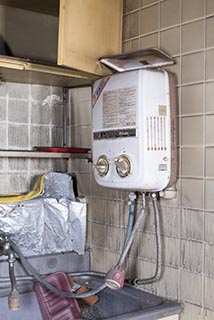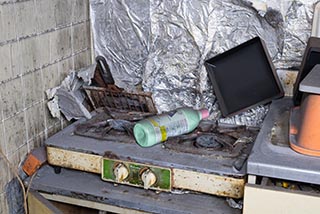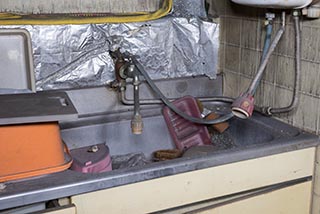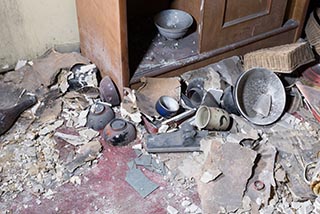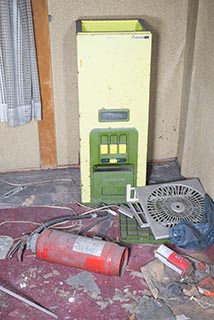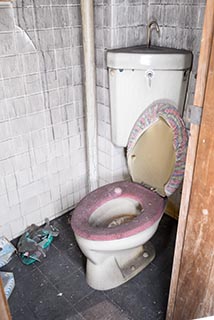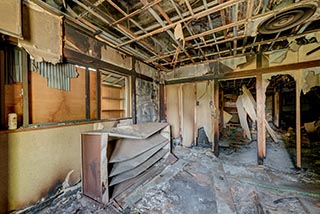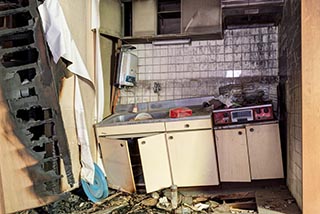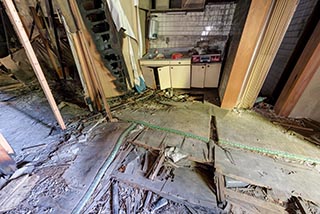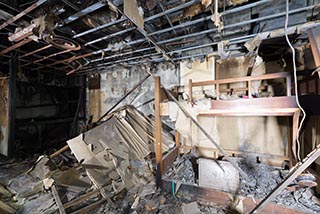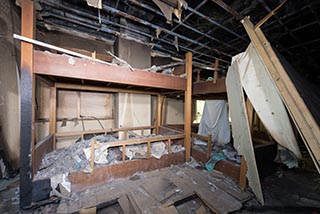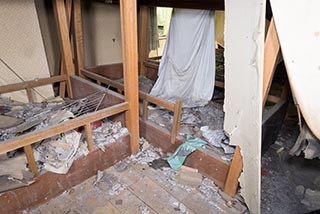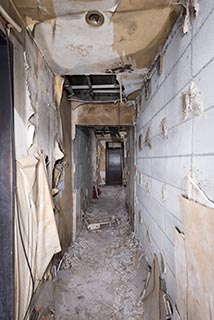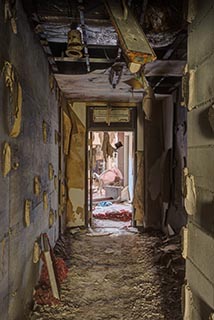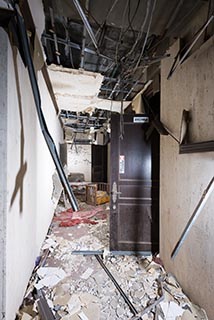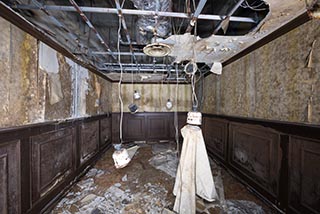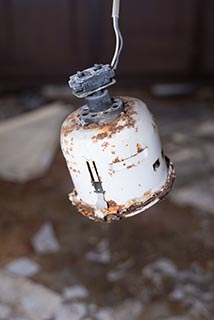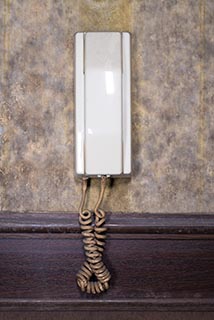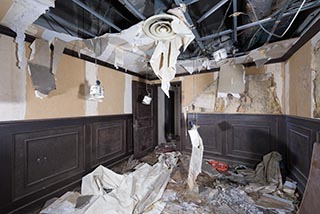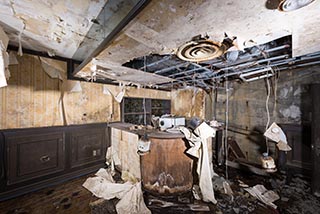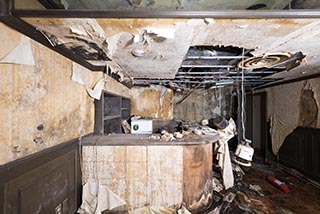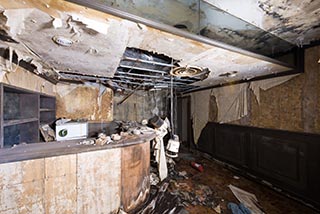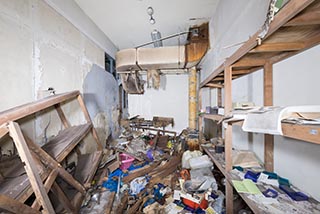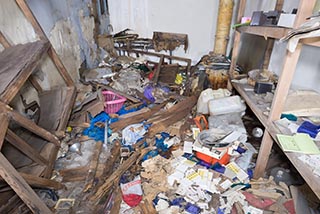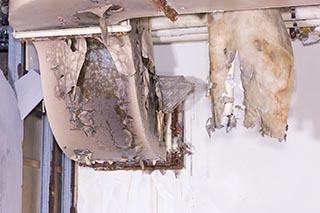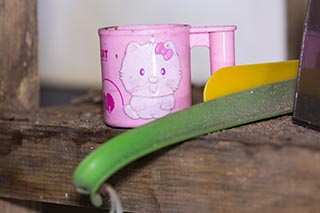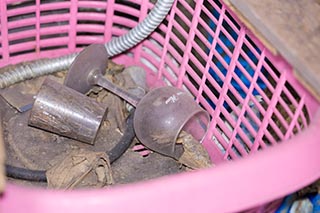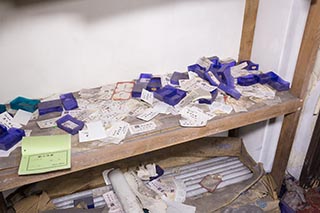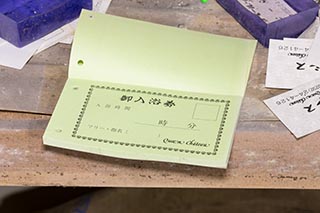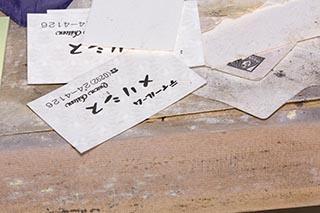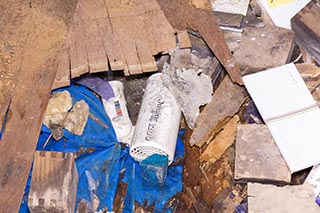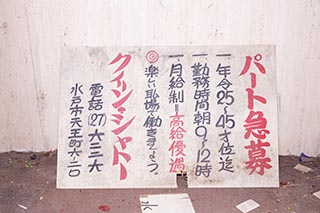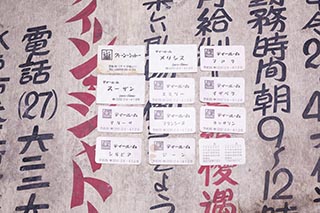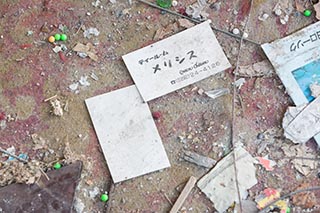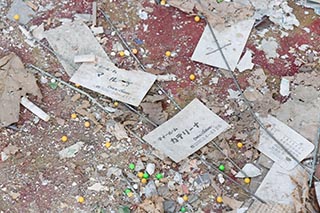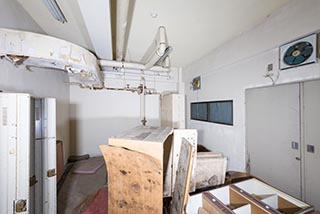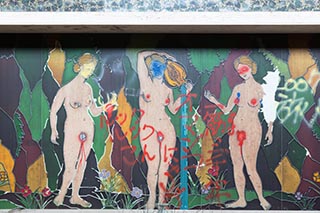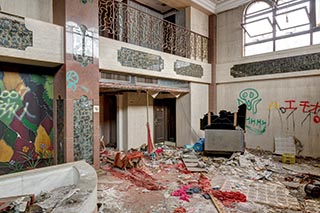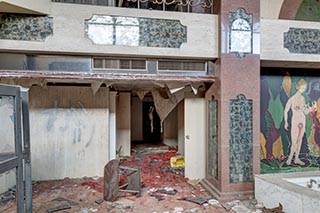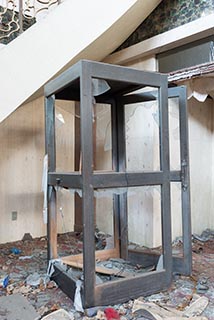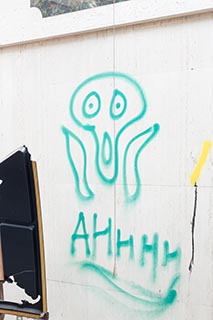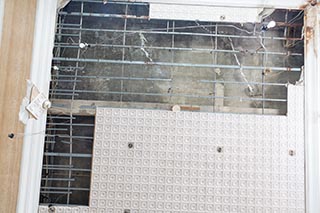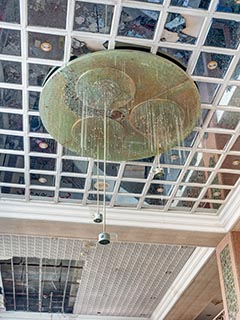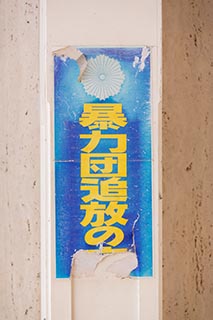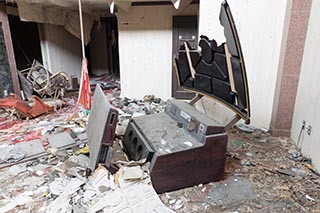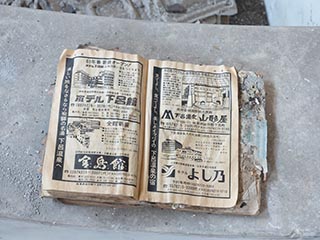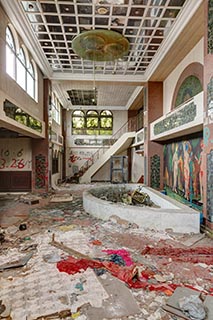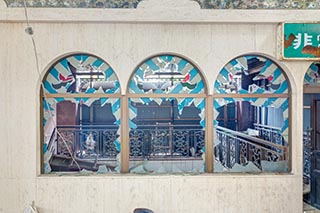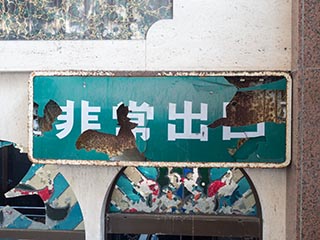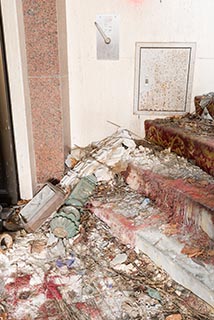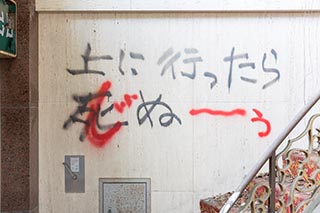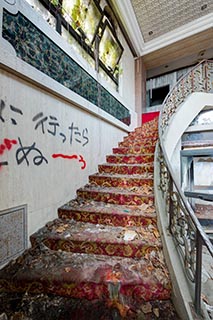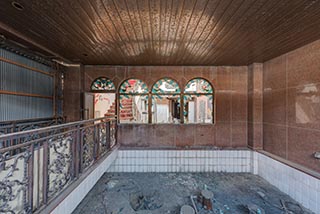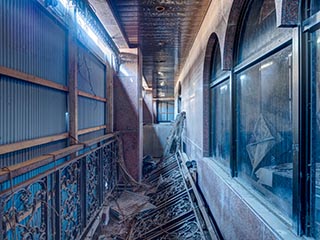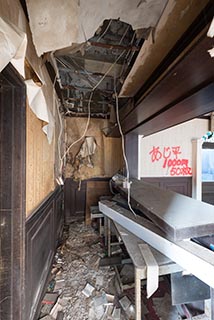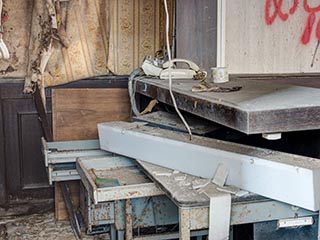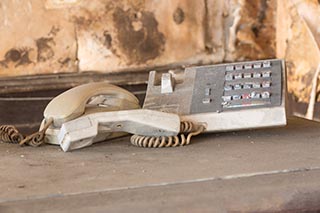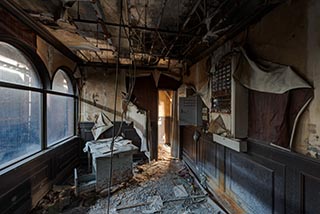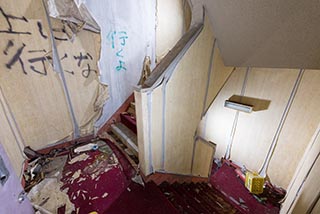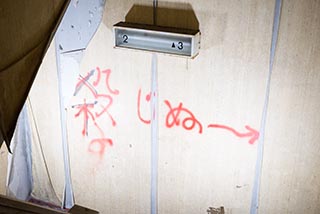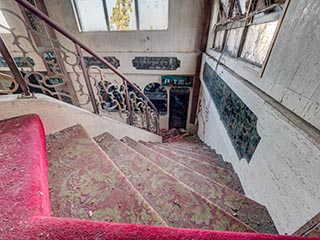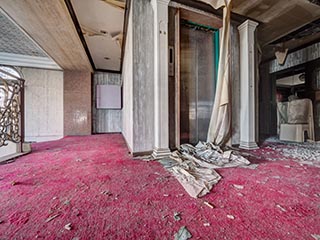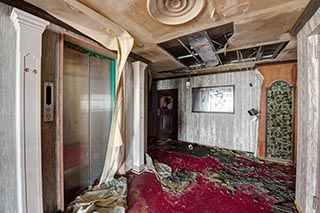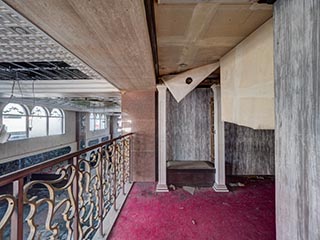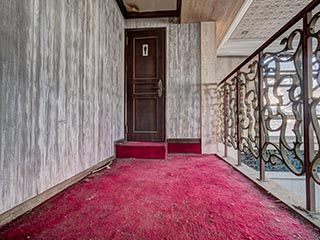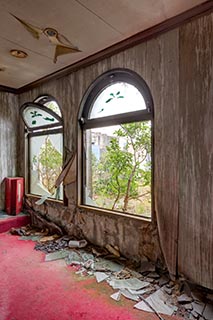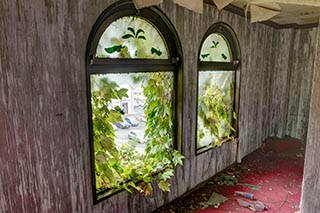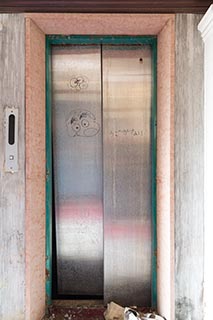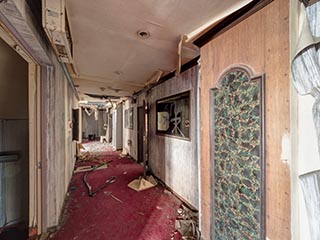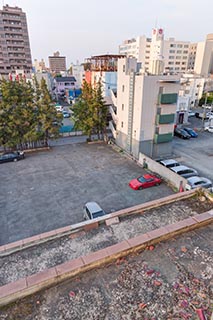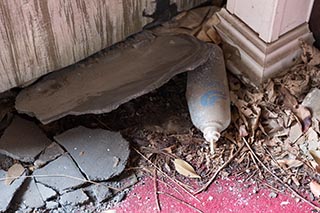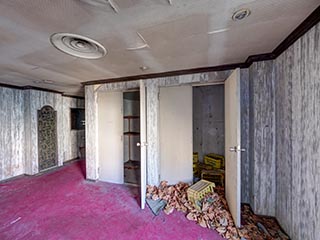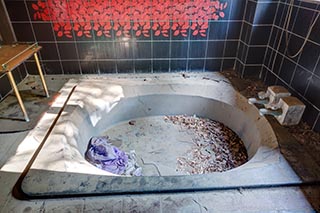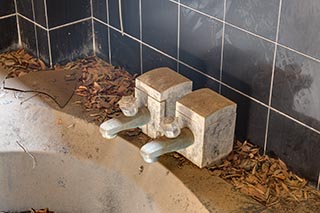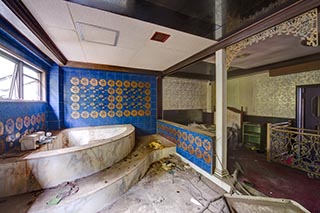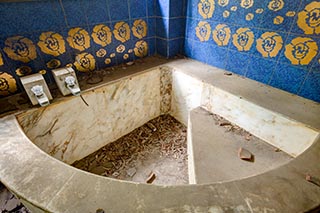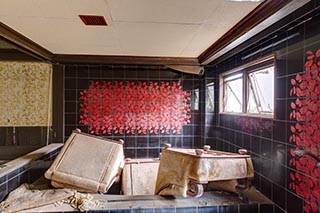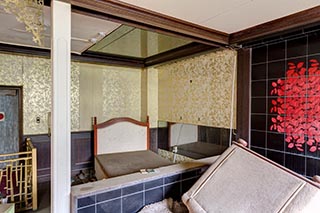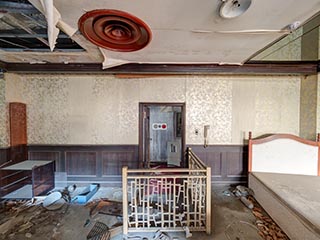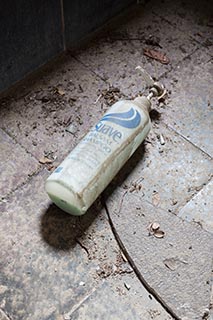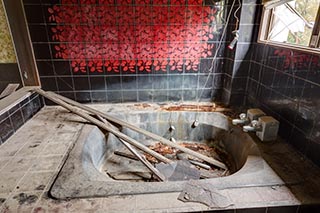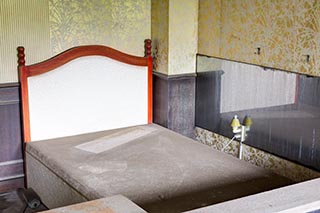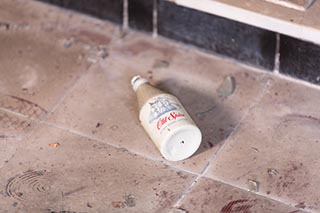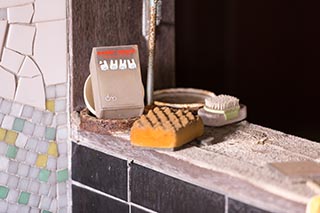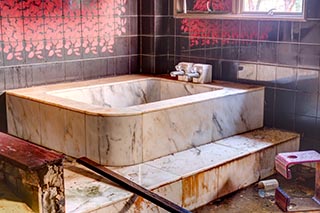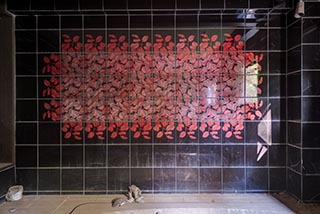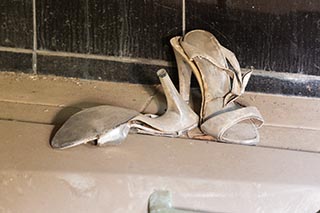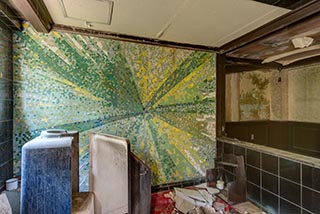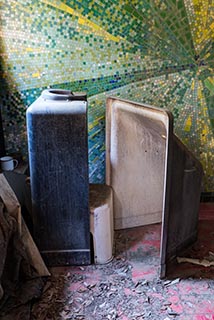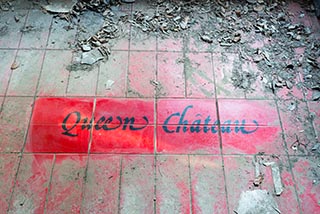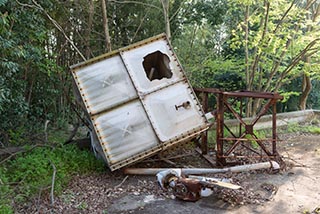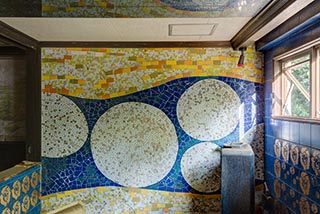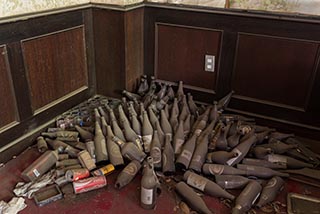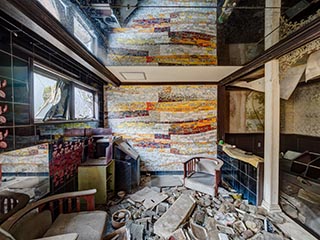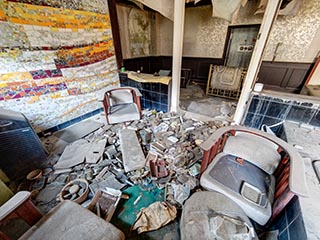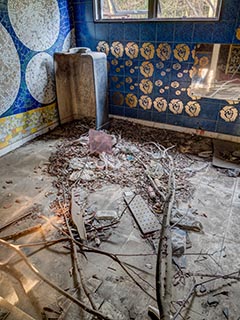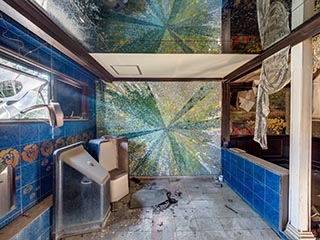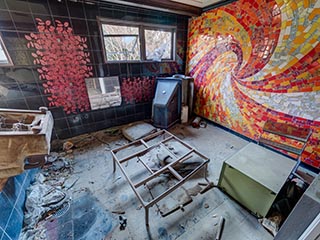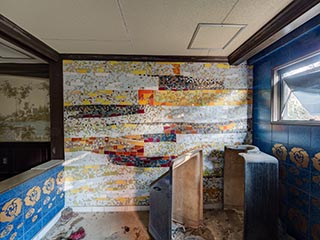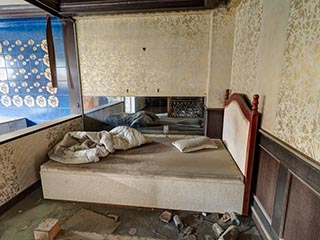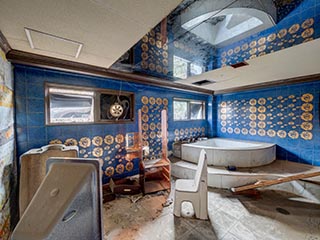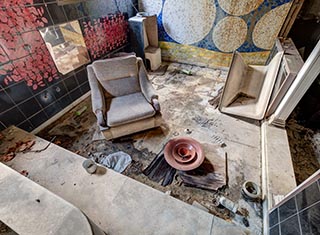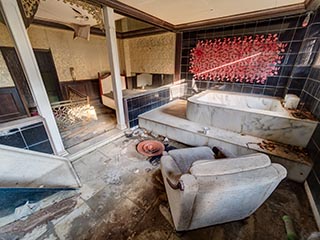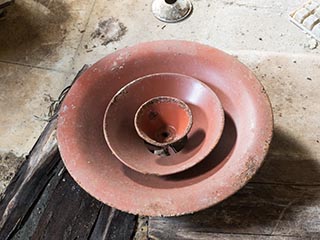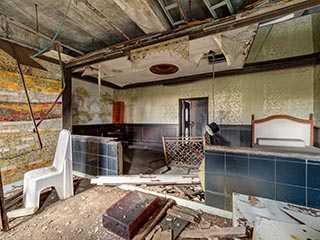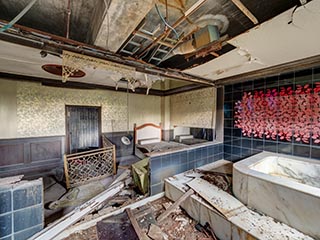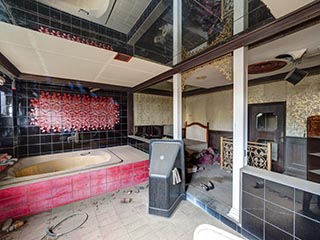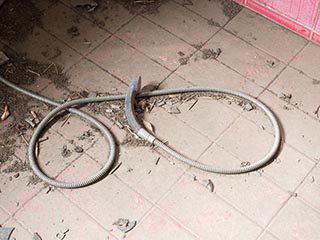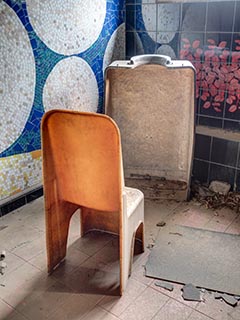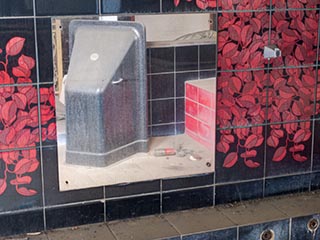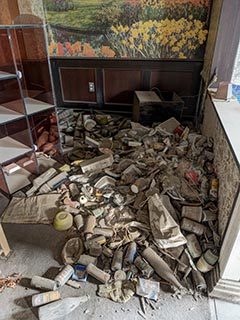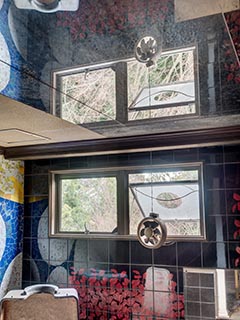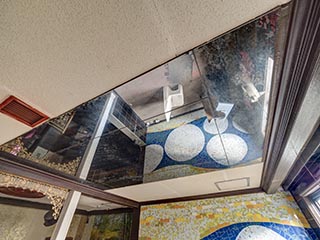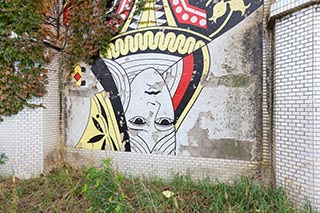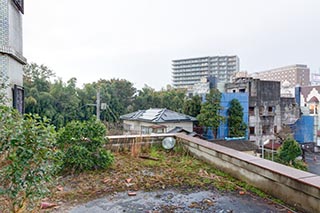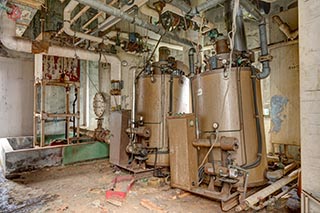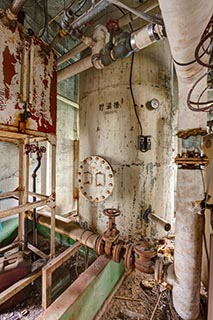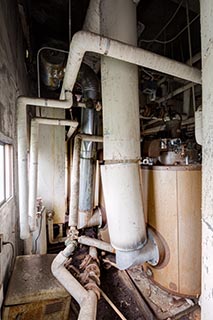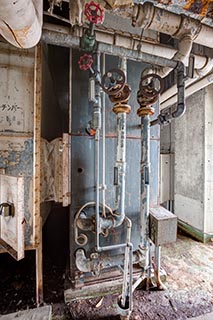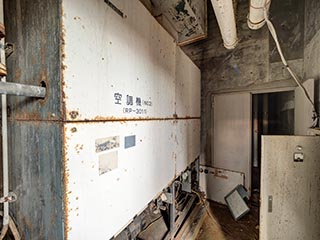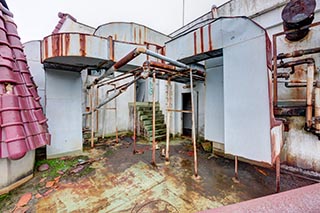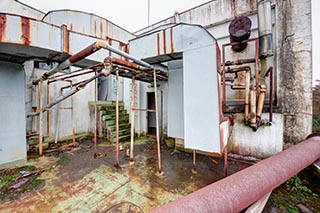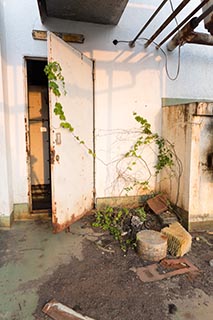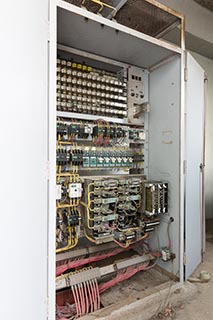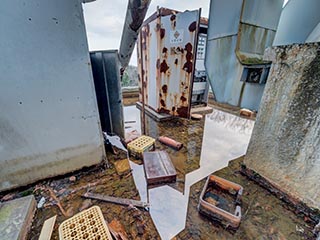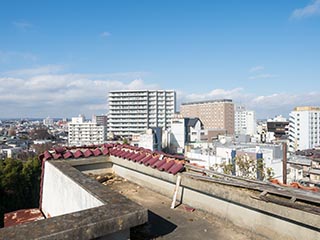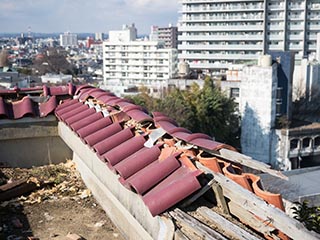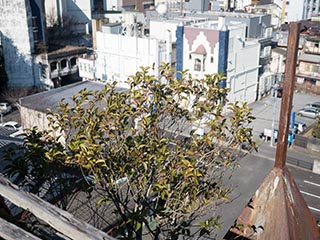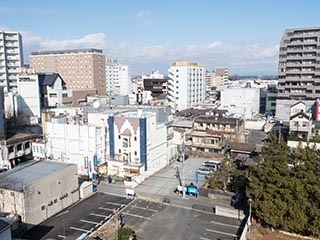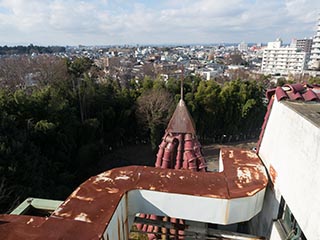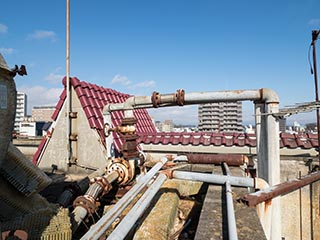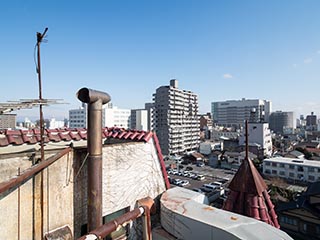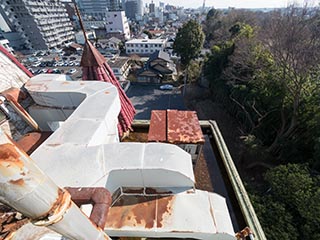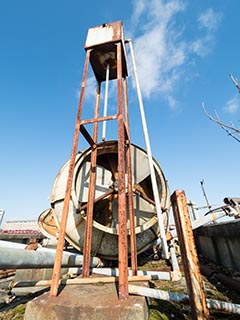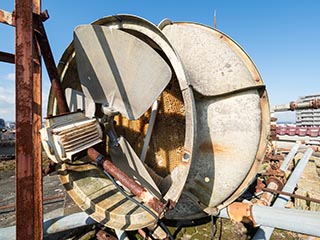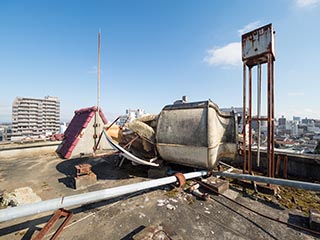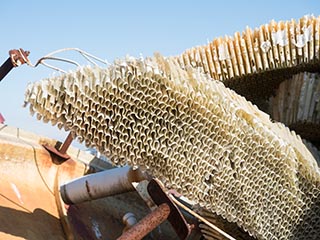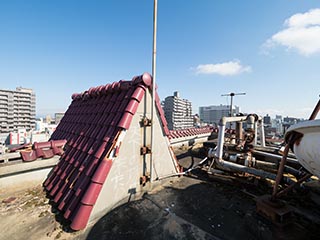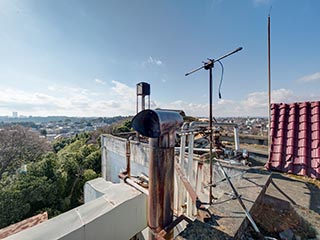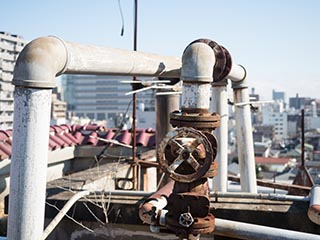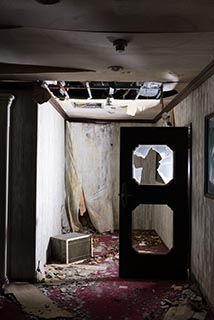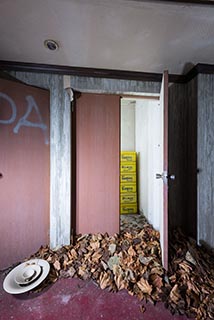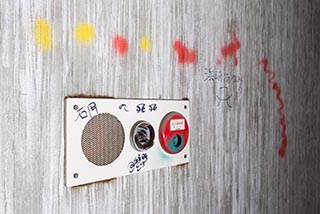The Queen Château Soapland is the ruin of a luxurious adult entertainment establishment in the town of Mito, Ibaraki Prefecture. I read about it on the Internet in November 2013, and immediately decided to pay it a visit. I couldn't find a website that gave its location, but there was enough information to find it quite easily with a little online detective work. I made another visit in April 2014 to photograph the parts that I missed the first time. I visited a third time in January 2016, this time accompanied by a friend and fellow photographer.
The Queen Château stands on the edge of a still thriving red light district. Although it's been abandoned for decades, it remains an imposing sight. The surrounding area is mostly occupied by parking lots, so there was plenty of room to get good camera angles. Although their business is theoretically illegal in Japan, Soaplands usually make no attempt to be discreet. On the contrary, they advertise their presence ostentatiously, with gaudy colours, bright exterior illumination, and large neon signs. The Queen Château was clearly no exception.
I have searched the Internet for some information on the building's history, but have been unable to find anything reliable - just rumours and speculation. For what it's worth, it's said to have opened some time in the 1980's, and closed shortly afterwards.
The front entrance was boarded up, so I walked around the back to look for a way inside. There was a system of tanks and pipes behind the building, which were presumably part of the water supply infrastructure. The rear doors and windows were also boarded up, but somebody had broken open one of the windows, through which I entered.
Employee Dormitory
I stepped through the window into a dark corridor, which led towards the lobby in the front of the building. The rear part of the ground floor was taken up by what appeared to be an employee dormitory. With most of the windows boarded up, it was dark and gloomy, and years of water damage, vandalism, and at least one fire had reduced it to a filthy shambles. However, the remaining furnishings suggest that it used to be a comfortable, perhaps even cosy place. Note the remains of tatami mats, and kitchen areas like those in a typical Japanese apartment.
The only thing that shocked me was the padded toilet seat cover. These things must be one of the worst ideas in human history - they catch stray drops of toilet water and other liquids, and create a terrific breeding ground for germs. I have no idea why any sane person would buy one.
There was a little purplish-blue dress lying on top of one of the overturned lockers. I saw the remains of similar dresses in other parts of the building. I assume that they were uniforms once worn by the employees.
A corridor led from the dormitory to an area behind the lobby, which contained the central stairwell and a miscellaneous collection of rooms.
Waiting Rooms
I believe that "companion" is the usual polite euphemism for the ladies who provide the services in establishments such as this. I think these two rooms were probably where the customers waited to meet their companions.
Bar
The establishment had a small bar, for customers who liked to mix their pleasures. I only had time to take a few photographs here before the batteries in my LED panels ran out.
Store Room
This was obviously a store room. Some of the shelves had collapsed, and the remains of various supplies littered the floor. A "help wanted" sign lay face down on the floor just outside the door. I propped it against a wall to photograph it. A fairly close translation is:
Part time workers wanted
Age around 25 to 45
Working hours 9:00 AM to 12:00PM.
High monthly salary
Let's work at a fun workplace.
Queen Château
Telephone (27) 6226
Mito City Tennouchou 6-20
The sign doesn't specify the nature of the work, but from the working hours and the minimum age of 25, it's safe to assume that they were looking for support staff such as cleaners rather than companions.
I found a selection of business cards which must have belonged to the companions, and took a photograph of them laid out on top of the help wanted sign. For obvious reasons, companions generally use pseudonyms. Strangely, those at the Queen Château all used foreign names, which were rendered in Japanese katakana characters on the cards. The first one is "Merishisu"; I have no idea what name it's supposed to represent. The others are Farah, Susan, Emily, Isabella, Theresa, Francine, Katherine, Silvia, and Jean.
The employees of soaplands are usually Japanese, or perhaps other Asian nationalities such as Korean or Chinese. I think it's extremely unlikely that a soapland in Mito in the 1980's would have been staffed exclusively by women of European extraction. It's more likely that giving the companions foreign pseudonyms was just a rather lame attempt to appear exotic.
Storage and Locker Room
This looked like a combination storage, machinery, and locker room. The closed steel double doors would have been a side entrance to the building.
Lobby
The lobby was a mess. Assorted rubbish, including much of the ceiling, littered the floor, and the remains of a chandelier had come to rest in what was once a fountain. The walls had been defaced by tasteless graffiti. Even so, it was easy to see that it must have been a high class place in its day. A staircase at one end led to the second storey. Some Japanese graffiti warned of death for anyone who went upstairs, but I decided to risk it.
During my second visit two young Japanese men entered while I was photographing the fountain near the bottom of the stairs. I gathered that they were wannabe ghost hunters; they asked if I had come in search of ghosts, but I replied that I'd just come to take photographs. They went upstairs ahead of me, and I didn't see them again. I don't believe in ghosts, but the Queen Château does somewhat resemble the stereotype of a place that ought to be haunted.
The Queen Château is quite famous amongst ruin enthusiasts. During my third visit I briefly spoke to one of the locals, who told me that people often come to explore the place.
There was a narrow veranda around the front of the building, surrounded by a decorative wrought iron (or imitation wrought iron) fence. This had become enclosed when the front of the property was boarded up. There was a fountain, which had long since dried up, by a side entrance near the bottom of the stairs.
Office
The business had a front desk like a hotel, with a small office behind. There was an intercom system and some sort of control panel on the wall.
I looked for anything with a date to try to establish when the place was last open. The only things I could find were some old notebooks that apparently kept track of the cleaning. They were undated, but I noticed that the place to write the date was printed with the Shōwa period, which ended in 1989. This at least tends to confirm that the place closed in the 1980's.
Upstairs
Two elevators once carried customers and staff to the upper storeys, but for obvious reasons I had to use the stairs. The stairs at the end of the lobby were the easiest way to the second storey. A single stairwell behind the lobby provided the only access to the rest of the building.
There were four floors of guest rooms, starting on the second storey. Three rooms on each floor made for a grand total of twelve rooms. The elevators, stairwell, and corridors were in the front of the building, and the guest rooms were in the rear. The second storey overlooked the lobby, which extended from the front of the building.
Guest Rooms
The guest rooms were all built to the same basic plan, with a large tiled area for bathing and related activities, and the rest of the room raised on a false floor. The rooms were decorated with ornate tile murals of various designs. The décor must have been expensive, and I thought it was tasteful and classy.
I wasn't so impressed by the beds, however, which were too small for an establishment like this. Having to work in a cramped space would have made it difficult for the companions to perform to the best of their abilities. There was plenty of room for bigger beds, and the cost would surely have been insignificant compared to the lavish sums that must have been spent on the rest of the building. It seems like a strange oversight.
After around three decades of abandonment the rooms were, not surprisingly, decaying, filthy and messy. The false floors were collapsing in places. There were a lot of cans, bottles, and food wrappers lying around, which were presumably left by squatters. One room was flooded with water leaking through the roof above.
Lower Roof
I stepped through a window on the third storey onto the roof above the lobby. Some quite large bushes had taken root here. Spotlights in the corner would have lit up the mural of the queen at night, when the place was still in business.
Boiler Room, Elevator Motors, and Roof
I was curious to see what was behind the single dormer window in the roof. I imagined that it was an executive penthouse suite or something similar. I was disappointed to learn that the window was a fake, added purely for ornamentation. The space immediately behind it was the top of the stairwell.
The roof level contained the building's boiler room, and the motor rooms for the elevators. The aqueous nature of the entertainment provided in a soapland requires a plentiful supply of hot water, so the Queen Château had some heavy duty water heating hardware.
Part of the roof had become a shallow pond, which would explain the flooding in the room below.
An exterior ladder led to the roof of the boiler and elevator motor rooms, at the very top of the building. I didn't bother going up on my first two visits, because I'd left my tripod bag in the car, and climbing the ladder while holding the tripod would have been difficult and dangerous. I had a good look during my 2016 visit. I could have been seen by anyone who happened to look up, but I think the locals are used to people exploring the Queen Château and don't really care.
After Dark
On our 2016 visit we stayed until after dark, when the Queen Château becomes a lot creepier, even if you don't believe in ghosts. We did a few lighting experiments with my LED panels to try to capture the atmosphere of the place. For our final shots of the day we lit up the queen mural in an attempt to simulate the floodlights that were in use when the place was open.
